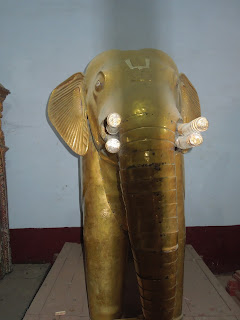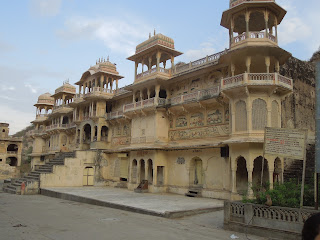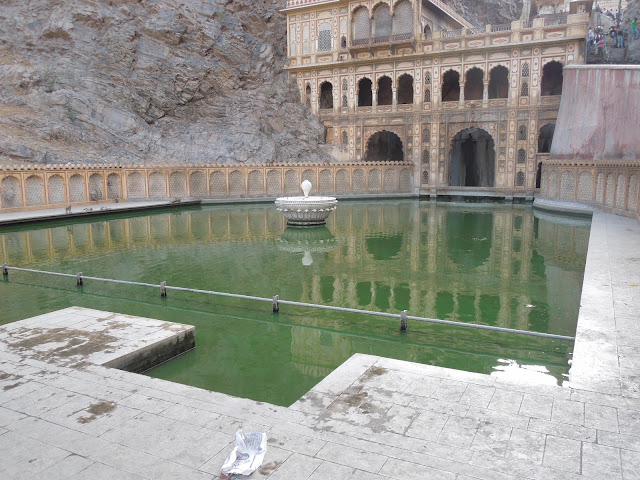Hello friends,
Today I will tell you about my visits to Agra, which is known to be the city of Mughal Architecture. Agra comprises of such beautiful examples of Mughal architecture that cannot be just said by words. There are countless monuments that are situated in Agra. You all must have heard about the famous monument known as one of the wonders of world, Taj Mahal. But in this blog I will tell you about other monuments of Agra, rather than Taj Mahal, so that you can enlighten your knowledge about Agra at a wider context than only Taj.
First I visited Sikandra. Sikandra is one of the superb Mughal buildings, which is situated about 7 Km. from Agra city on Agra-Mathura Road.
Emperor Akbar the Great selected this place for his burial and started the construction work in 1602 A.D., but it could not be completed as Akbar lived. He was buried here as per his wish in the catacomb. The main building was constructed by Akbar only but was completed by Emperor Jahangir in 1613 A.D. with a cost of Rs 15 Lakh. This Mausoleum stands in a big garden called Bahishtabad in an area of 150 acres, and is enclosed by a huge wall about 25 feet high having 4 gates towards all the four sides.
 |
| The Main entrance gate to Sikandra |
The gate way of Sikandra is extremely beautiful and is situated on the south side. It is made of red sand stone. Its main door was made of sandal wood, which was taken away by the Jats. Formerly the roof of this gate was decorated with silver and gold which was taken over by Jats during their short rule. The upper storey of the Gate has a 'Naubat Khana', from where the big kettle drums were played in the morning to evening in the honour of the dead Emperor. The roof has got four couplas marble and red stone which is surrounded by beautiful 'kangura' work. The exterior portion is profusely decorated with white marbel inlay work. On either sides of the gate way are built court yards of red sandstone, which are called 'Nau-Mahals'.
From the main gate to the main building there are stoneways paved with red stone having some small tanks and cannals. The main building is squarish having 4 storeys and about 100 feet high. the first three storeys are of res stone while the fourth one is of white marble, which is a clear evidence that the first three stories of red sandstone were built by Akbar while the fourth one was built by his son Jahangir. The Mausoleum proper stands on a marble platform of 496 feet square and 30 feet high.
 |
| The Mausoleum at Sikandra |
In the centre of the main building is the grave of Akbar situated on a raised platform, cut out of a single block of marble. There is an inscription on the Northern side of the cenotaph which reads like this-"Alla-ho-Akbar" (God is Great), and on the south "Jatt-e-Jalal Hoo", (Great is His glory), and around it there are ninety nine names of God, the almighty inscribed in stone.
 |
| The tomb of Akbar The Great |
Besides the tomb of Akbar there are the tombs of Jahangir wives and daughters of Akbar. These are also made of white marble.
 |
| Tomb of Akbar's daughters |
Near the main gate of Akbar's Tomb towards the south-east side, is a beautiful bilding called Sheesh-Mahal or the Palace of Mirror. It was constructed by Jahangir for his beloved consort Noor-Jahan. Its beauty is indescribable but its remains are in a dilapidated condition today.
 |
| Sheesh-Mahal |
After this I travelled to the famous Fatehpur Sikri, which is situated about 37 Km. west of Agra on Agra-Jaipur National Highway. It was small village named Sikri, dwelt by some stone cutters and was under Rajput cheifs upto 14th century. It is near the famous battle field of 'Kanwah' where a decisive battle was fought between Babur and Rana Sanga. It was famous for the dwelling place of a Sufi Saint 'Shekh Saleem Chisti', who was famous for his spiritual deeds.
When Akbar was returning from his victory over Gujrat, he made a hault at Sikri village just to have prayer to the Sufi Saint to bless Akbar with a son from his Rajput wife Jodhabai.
 |
| Shekh Salim Chisti Tomb |
Sheikh salim Chisti Tomb is made of white marble, the marble screen surrounding the cenotaph has beautiful floral design. The actual remains of the sufi saint are kept in a vault just below the cenotaph. Its a famous place of worship for people from all religions. There is a belief that if an individual wishes for something and ties a thread in the jali around the cenetoph, the wish will surely be fulfilled and if so happens then one has to visit here again and untie the thread. This saint was the guru of Akbar.
 |
| Jama Masjid |
Jama Masjid is the largest building in whole Fatehpur Sikri. It was constructed by Emperor Akbar on the pattern of the Mosque at the Mecca at the suggestion of Sheikh Saleem Chisti. It was completed in the year 1527 A.D. Akbar treated himself as one of the religious heads (Imam). It is said that on one Friday, he performed the prayers and read Khutba composed by Faizi but later on he left the service leaving to the original Mullah of the Masjid.
 |
| Buland Darwaza or Victory Gate |
Buland Darwaza was constructed by Akbar in 1602 A.D. to commemorate his victory over South India. It is towards the south of Jama Masjid. It is said to be the greatest and tallest Gate way in India. There are so many stairs steps below this gate which increases its own class, it is one of the greatest doors of the world. There are some Arabic Texts inscribed on it.
 |
| Jodha Bai Palace |
Jodha Bai's Palace is a double-storied edifice having its entrance towards the south. This building is having pure Hindu influence on its architecture as well as in the ornamental carvings depicting belts and chains on the stones. The northern and the southern wings are covered with beautifully glazed, azure-blue tiles from Multan.
 |
| Jodhabai's Kitchen |
Besides Jodhabai Palace is the Kitchen of Jodhabai where the food for Jodhabai was prepared, as she was pure vegetarian so only vegetarian food was prepared for her.
 |
| Birbal's Palace |
The house of Raja Birbal, a palatial building is situated near the norh-west ci=orner of Jodha Bai's Palace. It is said that it was built by birbal for his beloved daughter. Mahesh Das alias Birbal was an intelligent man, was Akbar's Prime-Minister and was amongst one of the nine gems of Akbar. This building stands on a huge concrete platform. It is a double storied building having flat roofs accessible by narrow staircase. The central part of the edifice is having four square rooms, It contains beautiful carvings on the walls, interior and exterior, along with the ceilings. It is a beautiful mixture of Hindu and Muslim architecture. Both the apartments are crowned with the domes on the two corners of the roof, which enhances the beauty of this building.
 |
| Panch Mahal |
Panch Mahal has five storeys. It is the beauty of this building that every upper storey of this building becomes smaller than the lower one. It appears like a 'Buddhist Vihar' in appearance.
It appears that the entire building was meant as a place of recreation by Akbar with his wives.
 |
| DIWAN-E-AAM |
Akbar the great, constructed this building known as the Hall of Public Hearing from 1570 to 1580 A.D. In its centre is situated the Emperor's seat of judgment on an elevated recess. On the three sides of this Diwan-E-Aam, there are some cloisters capable of seating thousands of litigants and petitioners while on the fourth side roof of the seat, provided seats for ladies of the royal Harem.
 |
| DIWAN-E-KHAS |
There is a red sand stone building near Diwan-E-Aam, which was known as Diwan-E-Khas or Ibadat Khana. It is a building having in its centre, a lofty chamber, consisting of a lofty octagonal beautifully carved column. On the top of the pillar is a platform which is enclosed by pierced screen carvings. At all the corners of the platform, there are some kiosks, approchable by two staircases, hewn in the thickness of the walls, the Emperor used to reach his seat by some marble steps, which could be slid beneath the platform. The Emperor used to sit here with his nobles in line, according to there respective ranks. From this place only Akbar used to give 'Jaarokha Darshan' to his subjects daily in the morning.
 |
| Turkish Sultana's House |
The Turkish Sultana's House was built with red sandstone and its interior and exterior is ornamented with superb carvings. Its interior portion was decorated with scenaries, flowers and birds which was destroyed by Aurangzeb later on. Turkish Sultana was the chief wife of Akbar, who was the daughter of Hindal, the son of Babar. She was childless who died in Agra in 1626 A.D. at the age of 54 years.
Here I am mentioning the main buildings of Fatehpur Sikri. After this I went to Dayal Bagh.
Dayal Bhag is about 6 Km. from the collectorate. It is the birth place of a religious sect 'Radha Swami', which was founded by Swami Shiv Dayal Ji in 1861 A.D. This sect is headed by religious 'Gurus' and its followers are spread in all parts of at least North-India along with some followers throughout many countries of the East and the West, but of course Indians by birth. The main attraction of Dayal Bagh is the Samadhi of the 'Sat Guru Maharaj' in white marble, with in lay work of semi-precious stones. It is under construction since 1915 A.D. but the construction work is a bit slow.
Here photography was completely restricted so, I could not take photographs of the place.
It is a piece of marvellous artistic work on the pattern of the Taj in white marble with floral designs in other coloured stones. Whatever work has been completed so far, is of immense artistic value and worth visiting. Near the samadhi there is a good colony, meant for the followers of the Radha Swami faith.
That's all for the day. In my next post I will tell you more about the temples of Vrindavan.
Thank You

















































